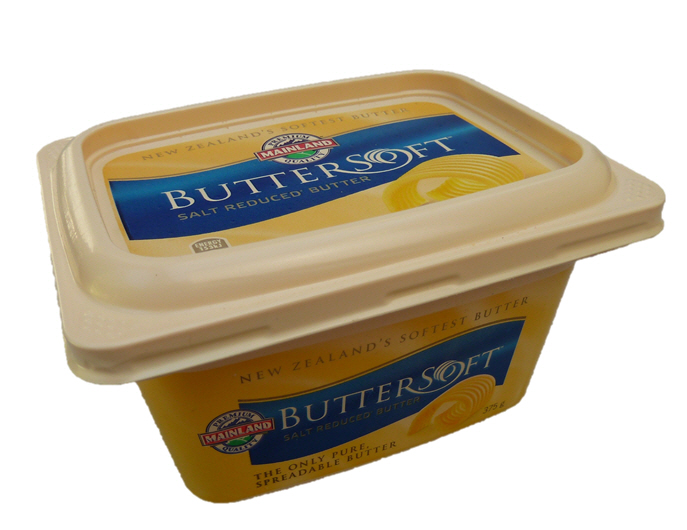- Home
- Blog
- Fats and oils
- Butter blends - are they any good for you?
Butter blends - are they any good for you?
Written by Catherine Saxelby
on Tuesday, 14 August 2012.
Tagged: butter, cholesterol, fats, margarine, oil

At 80 per cent fat, pure butter’s got a great taste and is all-natural, but it’s hard to spread thinly straight from the fridge. It’s high in saturated fat so not for anyone with high cholesterol. However, if you love the taste of butter and can’t stand the alternative, the best compromise may be a soft butter or a butter-oil blend. In this article I’ll tell you how they’re made and which ones to go for.
Pure butter in a solid block or tub
Butter contains 80 per cent fat, of which over half (53 per cent) is the ‘cholesterol-raising’ saturated fat. The remaining 20 per cent is water. There’s almost no protein or carbohydrate.
MADE FROM:
Cream churned with water and salt. I categorise butter into these four types:
- Full-salt 2% salt
- Salt-reduced 1% salt – this is the one I prefer
- Unsalted – no added salt – good for baking
- Cultured (soured) or "European-style" butter - made by adding a live culture similar to the bacteria in yoghurt or sour cream. This adds a lovely tangy flavour that I find attractive.
Pros:
Adds a rich flavour to cooking and on toast. More ‘natural’ than margarine. Good source of fat-soluble vitamins A and D but this varies with the season. There are higher levels of these vitamins after summer.
Cons:
High in saturated fatty acids which can raise cholesterol. Hard to spread thinly so you end up eating more than you want to – or really ought to.
TIP:
If you love the taste of butter but need to watch your cholesterol, save it for those times when you really can taste it – on fresh bread or toast say. Cook with oil to compensate.
INGREDIENTS:
Cream, water, salt.
Spreadable butters in a tub 1
(eg Lurpak, Western Star, Devondale)
 These are blends of butter with oil but generally they contain a lower 60 per cent of total fat, of which 33 per cent is saturated fat. There’s extra water whipped in so you get less fat overall.
These are blends of butter with oil but generally they contain a lower 60 per cent of total fat, of which 33 per cent is saturated fat. There’s extra water whipped in so you get less fat overall.
Made from:
Butter blended with 20 to 30 per cent canola oil or olive oil
Pros:
Less saturated fat and softer than regular butter – you can spread them straight out of the fridge.
Cons:
Still high in saturated fat – not recommended by the Heart Foundation if you have high cholesterol.
TIP:
If you love butter, this is a good compromise. Buy the salt-reduced versions which have half the salt of the regular – you won’t notice the difference.
Many folk make their own whipped butter by beating softened butter with an electric beater and slowing trickling in a stream of olive oil. Use around half oil to half butter by weight. My colleague Munaiba Khan beats in one cup cold-pressed extra virgin olive oil into a 250 g half-tub of butter, which she says takes your bad fats down to around 25 per cent and makes the butter more spreadable.
INGREDIENTS:
Cream, canola oil (27%), water, salt, vitamins A&D (this is the ingredient list from Devondale in a tub)
Spreadable butters in a tub 2
 (eg NZ Mainland Buttersoft)
(eg NZ Mainland Buttersoft)
This is a ‘modified’ butter that contains 81 per cent fat, of which 50 per cent is saturated fat so essentially it’s the same as regular butter.
MADE FROM:
Butter with some of the harder saturated fat melted and drained off. It sounds as if it’s got the same three ingredients as pure butter but it’s gone through a heat-and-melt process to create the softer fractions only. So it’s not as ‘natural’ as the old-fashioned type.
Pros:
More soft than regular butter – you can spread it straight out of the fridge so you put less on your bread.
Cons:
High in saturated fat – not recommended by the Heart Foundation if you have high cholesterol.
INGREDIENTS:
Cream, water, salt
(ingredient list from Mainland Buttersoft spreadable butter )
The bottom line
- If you’re a purist and want to eat simply and naturally, stick to the old-fashioned block of butter and make a routine of cutting a slice off the block and leaving it out at room temperature for the day’s use. Spreading kids' school sandwiches then becomes much simpler.
- If you’re after convenience in the tub, either of my two butter blends above is a healthy alternative. Buy a tub and see which taste you and your family prefer. My suggestion is to choose those that are salt-reduced.
- If you want to lose weight, any sort of butter is a trap as it’s hard to spread thinly (and tastes divine so you eat more). Best to opt for a thin scrape of margarine. See my take on Butter vs margarine.
- If you have high cholesterol, you should be spreading a sterol spread like Pro-activ or Logicol.
You may also be interested in...
Foodwatch
The Good Stuff
The Boring Stuff
© 2025 Foodwatch Australia. All rights reserved
Website by Joomstore eCommerce









